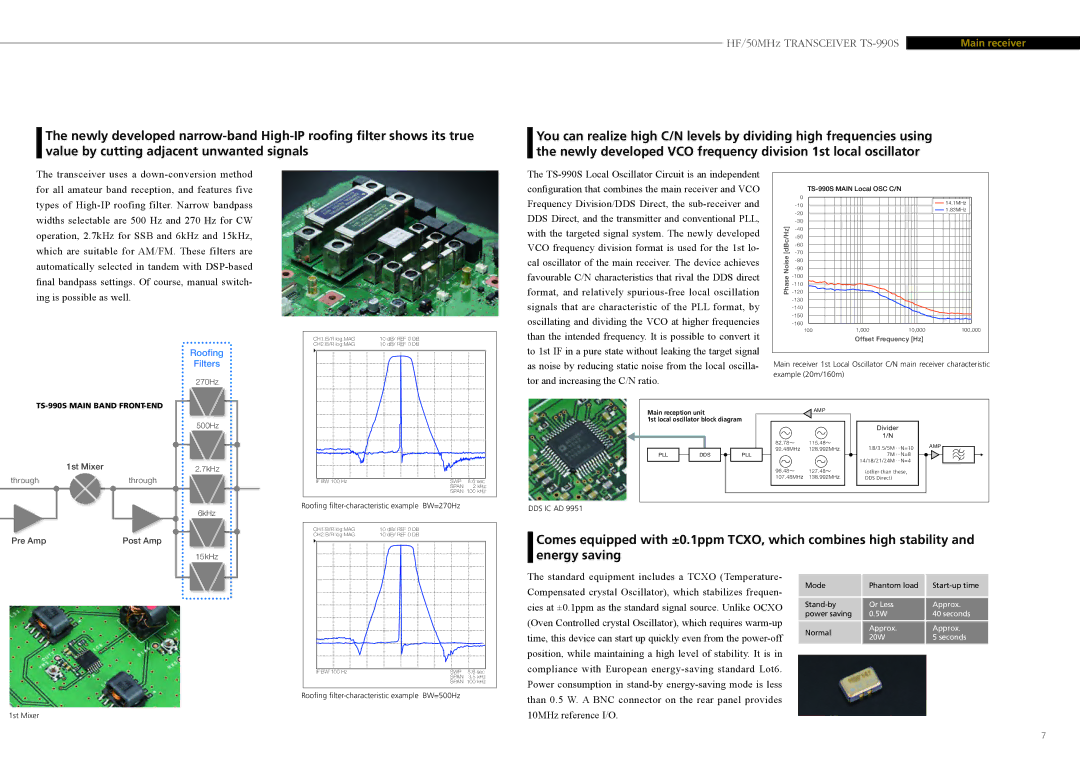
HF/50MHz TRANSCEIVER | Main receiver |
The newly developed
You can realize high C/N levels by dividing high frequencies using the newly developed VCO frequency division 1st local oscillator
The transceiver uses a
The
| 0 |
|
| 14.1MHz |
|
|
| ||
|
|
| 1.83MHz | |
|
|
| ||
|
|
|
| |
|
|
|
| |
[dBc/Hz] |
|
|
| |
|
|
| ||
|
|
| ||
|
|
| ||
Noise |
|
|
| |
|
|
| ||
|
|
| ||
|
|
| ||
Phase |
|
|
| |
|
|
| ||
|
|
| ||
|
|
|
| |
|
|
|
| |
|
|
|
| |
|
|
|
| |
| 100 | 1,000 | 10,000 | 100,000 |
Roofing
Filters
270Hz
CH1 B/R log MAG | 10 dB/ REF 0 DB |
CH2 B/R log MAG | 10 dB/ REF 0 DB |
than the intended frequency. It is possible to convert it to 1st IF in a pure state without leaking the target signal as noise by reducing static noise from the local oscilla- tor and increasing the C/N ratio.
Offset Frequency [Hz]
Main receiver 1st Local Oscillator C/N main receiver characteristic example (20m/160m)
1st Mixer
throughthrough
Pre Amp | Post Amp |
500Hz
2.7kHz
6kHz
15kHz
|
| IF BW 100 Hz | SWP | 8.6 sec |
|
|
|
| SPAN | 2 kHz | |
|
|
| SPAN 100 kHz | ||
|
|
|
|
|
|
Roofing | BW=270Hz |
|
| ||
CH1 B/R log MAG | 10 dB/ REF 0 DB |
CH2 B/R log MAG | 10 dB/ REF 0 DB |
Main reception unit |
| AMP |
|
|
| |
|
|
|
|
| ||
1st local oscillator block diagram |
|
|
|
| ||
|
|
|
| Divider |
| |
|
|
|
| 1/N |
|
|
|
| 82.78~ | 115.48~ | 1.8/3.5/5M | ...N=10 | AMP |
|
| 92.48MHz | 128.992MHz | |||
PLL | DDS | PLL |
| 7M | ...N=8 |
|
|
|
|
| 14/18 /21/24M | ...N=4 |
|
|
| 96.48~ | 127.48~ | (other than these, |
| |
|
| 107.48MHz | 138.992MHz | DDS Direct) |
|
|
DDS IC AD 9951
Comes equipped with ±0.1ppm TCXO, which combines high stability and energy saving
1st Mixer
|
| IF BW 100 Hz | SWP | 8.6 sec |
|
|
|
| SPAN | 3.5 kHz | |
|
|
| SPAN 100 kHz | ||
|
|
|
|
|
|
Roofing | BW=500Hz |
|
| ||
The standard equipment includes a TCXO (Temperature- Compensated crystal Oscillator), which stabilizes frequen- cies at ±0.1ppm as the standard signal source. Unlike OCXO (Oven Controlled crystal Oscillator), which requires
Mode | Phantom load | ||
Or Less | Approx. | ||
power saving | 0.5W | 40 seconds | |
Normal | Approx. | Approx. | |
20W | 5 seconds | ||
|
7
